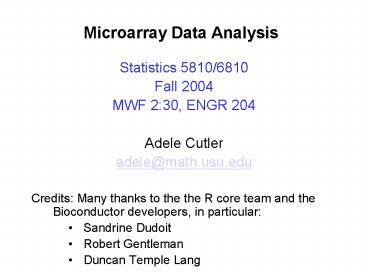Microarray Data Analysis - PowerPoint PPT Presentation
1 / 9
Title:
Microarray Data Analysis
Description:
http://rsb.info.nih.gov/ij/ Installing R ... Sys.putenv('http_proxy'='http://proxy.usu.edu:80/') Sys.getenv('http_proxy') source('http://www.bioconductor.org ... – PowerPoint PPT presentation
Number of Views:53
Avg rating:3.0/5.0
Title: Microarray Data Analysis
1
Microarray Data Analysis
- Statistics 5810/6810
- Fall 2004
- MWF 230, ENGR 204
- Adele Cutler
- adele_at_math.usu.edu
- Credits Many thanks to the the R core team and
the Bioconductor developers, in particular - Sandrine Dudoit
- Robert Gentleman
- Duncan Temple Lang
2
What is a Microarray?
- There are two main types
- spotted oligonucleotide arrays (e.g. Affy)
- two-color cDNA arrays
- An animation of the latter is provided at
- www.bio.davidson.edu/courses/genomics/chip/chip.ht
ml
3
Why are we interested in Microarrays?
- Biologists
- Use genome-wide measures of expression (mRNA
transcription levels) to predict biological
attributes - Identify gene interactions
- Compare genome-wide measures of expression
(phylogenetics, etc ) - Lots more
4
Why are we interested in Microarrays? (ctnd)
- Computer Scientists
- Image processing (spot detection)
- Machine learning, neural nets
- e.g. how can we predict whether someone has a
given disease (given 16,000 expression measures
and a training dataset of 80 cases)? - visualization
- Data warehousing and database management
- Lots more
5
Why are we interested in Microarrays? (ctnd)
- Statisticians
- large p small n problem (more variables than
cases) - Multiple comparisons
- Clustering and classification
- e.g. how can we learn about which genes are
important in predicting whether a person has a
given disease or not (given 16,000 expression
measures and a training dataset of 80 cases)? - visualization
6
What software will we use for microarray data
analysis?
- R for general data analysis www.r-project.org
- environment for statistical computing and
graphics - an open-source implementation of the S language
(commercial Splus) - CRAN www.cran.r-project.org
- omega www.omegahat.org
- Bioconductor for specialized microarray analysis
- www.bioconductor.org
- ImageJ for image processing/spot detection
- http//rsb.info.nih.gov/ij/
7
Installing R
- Available as source code, but easier to use
precompiled versions for - Windows
- MacOS
- Linux
- The R FAQs are useful if you run into problems
8
Installing R Details for Windows
- Go to www.r-project.org
- Under Download (l.h.s) select CRAN
- Select a mirror
- Save the windows version
- Select the appropriate operating system (Windows
?) - Select base
- Select rw1091.exe
- Save, then execute to install
9
Installing bioconductor
- In R, do
- gtSys.putenv("http_proxy""http//proxy.usu.edu80/
") - gtSys.getenv("http_proxy")
- gtsource("http//www.bioconductor.org/getBioC.R")
- gtgetBioC()
- The first two lines are only necessary if you
encounter problems with the firewall. They must
be used at the beginning of a new R session
(before trying to access the web)































